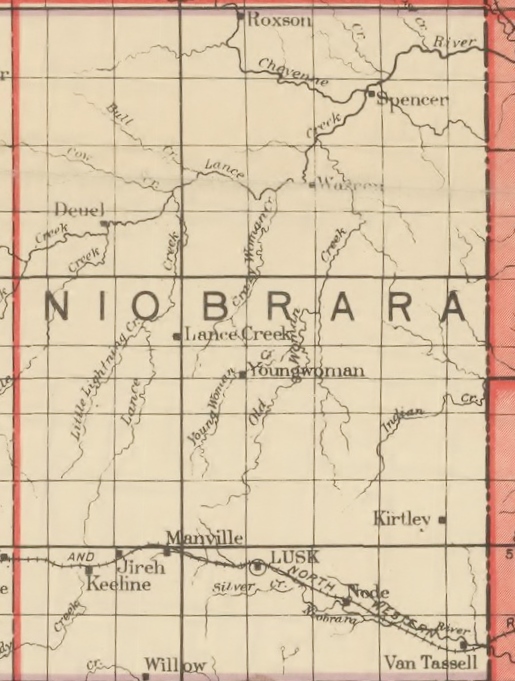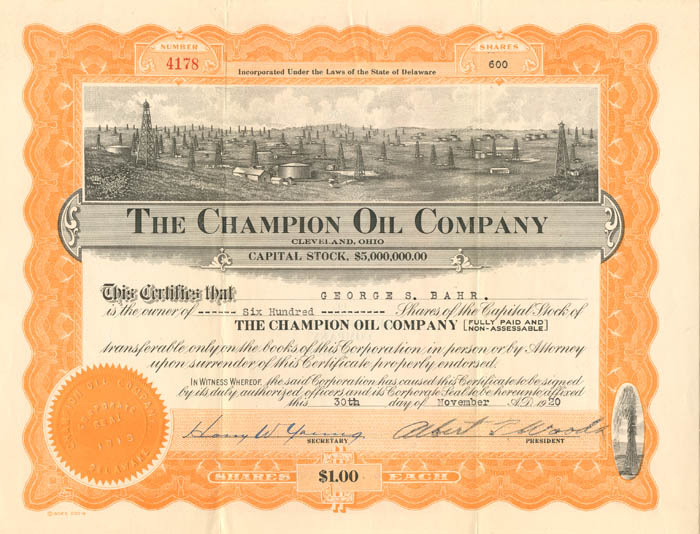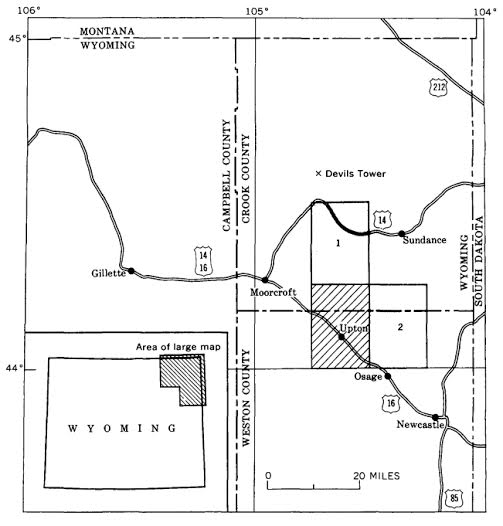by Bruce Wells | Jan 20, 2016 | Petroleum Companies
 As early as September 24, 1917, the trade journal Oil, Paint, and Drug Reporter reported that Clark Producing & Refining Company would be drilling a well on the “Old Woman Creek dome, adjoining the Norbeck-Nicholson holdings,” about 35 miles north of Lusk,Wyoming.
As early as September 24, 1917, the trade journal Oil, Paint, and Drug Reporter reported that Clark Producing & Refining Company would be drilling a well on the “Old Woman Creek dome, adjoining the Norbeck-Nicholson holdings,” about 35 miles north of Lusk,Wyoming.
The journal added the company held “acreage to the amount of 5,560 acres, and has two additional drilling outfits in transit for work as soon as they arrive on the property.”
The first Wyoming oil wells had arrived in 1890 near ancient “tar springs” north of Casper. Although Clark Producing & Refining’s leases were to east, near the border with Nebraska, the company was enthusiastically endorsed by newspapers, trade journals, and in advertisements soliciting investors.
In Lead, South Dakota, a quarter-page ad in the Lead Daily Call proclaimed in bold print “a harvest of profit awaits the investor in the Clark Producing & Refining Co.” and described holdings of more than 6,000 acres “in the heart of the Old Woman Creek Dome in the North Lusk Oil Field.”
The ad also promoted the company’s leases adjoining a 1916 local sensation, the Norbeck-Nicholson well at Cow Gulch. With one Clark Producing & Refining well about to be spudded (begin drilling) and a second rig planned, potential investors were advised to buy stock at only 26 cents per share to insure “Quick Profits.”
Drilling began on the company’s first well on Old Woman Creek in the southwest of the northwest quarter of Section 10, Township 36 North, Range 62 West. This lease location, described in Public Land Survey System terms, can be viewed in Google Earth and similar applications.
To fire the steam boilers to begin “making hole,” teamsters for Clark Producing & Refining’s hauled fuel oil from the Mule Creek field, about 15 miles to the northeast. By January 1918, a company rig had reached 1,200 feet deep.
When the Lusk Stock Exchange opened in February, Clark Producing & Refining was the first local petroleum stock to be placed on sale (see also the “Curb Market” described in Consolidated Petroleum Company). Drilling on the “Old Woman” well would continue into April 1922 as the company looked for more lease opportunities.
“COW GULCH STILL ALIVE,” proclaimed the Lusk Standard of November 26, 1920. The Oil Distribution News also reported events, noting, “The Clark Producing & Refining Co., composed mainly of Lusk citizens, is making headway with a test of the Young Woman dome, material has been assembled, and gas piped from the so called ‘Cow Gulch’ well completed some time ago by Norbeck and Nicholson.”
Powered by gas-fired boilers, drilling of the “Young Woman” well began. But at 1,472 foot depth, water intrusion into the well bore ruined the attempt. Meanwhile, the “Old Woman” well reached 1,900 feet deep and found a “considerable showing” of natural gas.
Managing multiple operations consumed Clark Producing & Refining Company’s the company’s rigging, equipment and casing supplies without yielding oil. In March 1922, National Petroleum News noted the company’s slow progress at the “Old Woman,” but predicted drilling would begin again “as soon as road conditions to the region are improved.”
A month later, Clark Producing & Refining was the only company still drilling in the eastern part of the Lusk oilfield, the other exploration companies having chased oil strikes further west into the Lance Creek field.
The company decided to use a down-hole explosive to “shoot” the “Old Woman” well at 2,100 feet deep to stimulate oil production, but fracturing did not succeed. The well “reached a depth of 2,160 feet when shut down for the winter. It is now waiting for the roads to become passable so as to move in fuel oil from the Mule Creek field.” No reports followed to indicate drilling ever began again. Like many of its contemporary high-risk petroleum ventures, Clark Producing & Refining likely just ran out of money.
___________________________________________________________________________________
The stories of exploration and production companies joining petroleum booms (and avoiding busts) can be found updated in Is my Old Oil Stock worth Anything? The American Oil & Gas Historical Society preserves U.S. petroleum history. Please support this AOGHS.ORG energy education website. For membership information, contact bawells@aoghs.org. © 2018 Bruce A. Wells.
___________________________________________________________________________________
by Bruce Wells | Jan 19, 2016 | Petroleum Companies

With hopeful prospects and properties in six petroleum-producing Oklahoma counties, Champion Oil Company began on October 25, 1919. The Muskogee-based company “engaged in the production of oil and the manufacture of casinghead gasoline.” Its balance sheet reflected more than $2.5 million in assets and the equivalent debt.
There were many exploration and production investment choices for investors seeking to cash in on the post-World War I Oklahoma oil booms. “For twenty-two years between 1900 and 1935 Oklahoma ranked first among the Mid-Continent states in oil production,” notes the Oklahoma Historical Society. “The state produced 906,012,375 barrels of oil worth approximately $5.28 billion.”
United States Investor proclaimed Champion Oil Company President Albert T. Woods as a highly regarded man of experience and ability. The magazine reported that Champion Oil had leased 2,000 acres of promising land in prolific Mid-Continent oilfields. The company’s stock sold for as much as $1.50 per share, with assurances that it would go to $2 a share.
Looking for investors to fund operations, the company peddled a prospectus promising 12 percent per year dividends. Sales were especially substantial in Cleveland and Syracuse, where salesmen earned a 15 percent commission.
Although the company apparently looked good to many investors, just two years later Poor’s Government & Municipal Supplement reported the company as “inactive at the present time.”
After stockholders had poured several hundred thousand dollars into the venture, Champion Oil Company was foreclosed upon and rendered bankrupt. U.S. Investor published a blistering indictment of Champion Oil and its president.
“Albert T Woods, the president and general manager, had shaken the dust of Muskogee and of Oklahoma from his feet, and had moved with his family to Hot Springs, Arkansas, where he set himself up as an independent oil operator, under the name of the Albert T. Woods Company,” the magazine noted.
With Champion Oil stockholders left with worthless paper, Woods made a brief effort to exploit the loss. He pitched an idea to exchange obsolete Champion Oil stocks for shares of the Revere Oil Company. This Revere Oil scheme is described in Arctic Explorer turns Oil Promoter.
According to the Commercial & Financial Chronicle of July 10, 1926, Champion Oil’s final curtain came when company shares were offered in lots of 12,000 shares for $5 (common) and 7,000 shares of preferred for $15.
___________________________________________________________________________________
The stories of exploration and production companies joining petroleum booms (and avoiding busts) can be found updated in Is my Old Oil Stock worth Anything? The American Oil & Gas Historical Society preserves U.S. petroleum history. Please support this AOGHS.ORG energy education website. For membership information, contact bawells@aoghs.org. © 2018 Bruce A. Wells.
___________________________________________________________________________________
by Bruce Wells | Jan 14, 2016 | Petroleum Companies
“Oil Excitement at Rocky Ford Field Near Sundance,” proclaimed a front page of the Moorcroft (Wyoming) Democrat on September 14, 1917.
“Rocky Ford, the seat of the oil activities in Crook county is about the busiest place around,” the newspaper continued. “Cars come and go, people congregate and the steady churning of the two big rigs continues perpetually. Excitement has reached the zenith of tension, and with each gush of the precious fluid, oil stock climbs another notch. The big drill of the Wyoming-Dakota Co. has been pulled from their deep hole until spring. The drill reached 600 feet and was in oil.”
The Rapid City, South Dakota, company was capitalized $500,000 with a nominal par value of 25 cents per share and reported to have one producing well and three more drilling. All the leases were in Crook County and included 3,200 acres in Lime Butte field; 10,000 acres in Rocky Ford field; and 4,000 acres in Poison Creek field.
 Since Wyoming would not pass its first “Blue Sky” to prevent fraudulent promotions until 1919, Wyoming-Dakota Oil’s newspaper ads often rivaled patent medicine exaggerations. For example, one ad noted “geologists claim this showing indicates alone 500,000 barrels to the acre.”
Since Wyoming would not pass its first “Blue Sky” to prevent fraudulent promotions until 1919, Wyoming-Dakota Oil’s newspaper ads often rivaled patent medicine exaggerations. For example, one ad noted “geologists claim this showing indicates alone 500,000 barrels to the acre.”
Wyoming-Dakota Oil further enticed investors with, “Your Chance Has Come if you want to make money in Oil.” In Sioux Falls, South Dakota, the Sells Investment Company offered Wyoming-Dakota Oil Company stock reportedly after “a careful selection of conservative issues from among the thousand prospects, offering same to you before higher prices prevail or its present substantial position has been discounted by professional traders. A good clean cut speculation of this character may mean a fortune. Watch this company for sensational developments.”
The United States had entered World War I in April 1917; by November newspapers reported Francis Peabody, chairman of the Coal Committee of the Council of National Defense, was telling the U.S. Senate Public Lands Committee that the country was not producing enough oil to win the war.
“He said if nothing were done to develop new wells the reserve supply would he exhausted in twelve months and production would be 50,000,000 barrels less than requirements,” one newspaper noted. Wyoming-Dakota Oil Company executives took advantage of the opportunity.
“The (war) situation outlined leads us to suggest that you investigate Wyoming-Dakota Oil. ‘We are doing our bit’ by drilling night and day. Ours is an investment worth while. The allotment of Treasury stock at 25 cents is almost sold out and the Directors will advance the price of stock to 50 cents a share (100 per cent on your present investment) on December 15th, 1917.”
The Wyoming-Dakota Oil promotion continued: “By that time our newspaper announcement in the Eastern cities, pointing out the enormous acreage, present production and negotiations for additional valuable holdings will be made known to millions of seasoned investors in New York, Philadelphia, Chicago, Boston and Pittsburgh. We feel confident this will result in a demand for this stock that will send the present market price skyward. We trust you will see the wisdom of prompt action before all available stock at 25 cents per share has been purchased by other investors.”
In early 1918, Wyoming-Dakota Oil Company’s had drilled wells in the Upton-Thornton oilfield and was “holding out high hope of bringing in a gusher in few days.” In July, the Laramie Daily Boomerang reported the company had “two rigs going steadily in Crook County’s Rocky Ford field” – but no oil gushers came in. Investor pessimism was reflected in Wyoming-Dakota Oil Company’s stock prices, which fell in over-the-counter markets from 75 cents bid in June 1919 to 50 cents bid at the end of September. By March 1920, brokers offered 5,000 shares or any part thereof at 5 cents a share.
A final blow to the company was reported in the Laramie Republican of July 25, 1921: “Wyoming-Dakota…has completed pulling the casing from the well which it has been drilling north of town, after having struck a formation said to be granite, at a depth of 715 feet. While this has a tendency to retard the activities of other interests, it is by no means stopping them entirely and it is to be hoped that another well will be started this summer.” It wasn’t.
Wyoming-Dakota Oil Company disappeared into history until a Summons was published 24 years later in the January 25, 1945, Sundance (Wyoming) Times. It advised that Wyoming-Dakota Oil – address or place of residence to plaintiff unknown – was being sued in the Sixth District Court of Wyoming. The company’s stock certificates today are valued only by scripophily collectors.
For the true story behind a Texas oilfield that did play a vital role in the “War to End All Wars,” read Roaring Ranger wins WWI.
___________________________________________________________________________________
The stories of exploration and production companies joining petroleum booms (and avoiding busts) can be found updated in Is my Old Oil Stock worth Anything? The American Oil & Gas Historical Society preserves U.S. petroleum history. Please support this AOGHS.ORG energy education website. For membership information, contact bawells@aoghs.org. © 2018 Bruce A. Wells.
 As early as September 24, 1917, the trade journal Oil, Paint, and Drug Reporter reported that Clark Producing & Refining Company would be drilling a well on the “Old Woman Creek dome, adjoining the Norbeck-Nicholson holdings,” about 35 miles north of Lusk,Wyoming.
As early as September 24, 1917, the trade journal Oil, Paint, and Drug Reporter reported that Clark Producing & Refining Company would be drilling a well on the “Old Woman Creek dome, adjoining the Norbeck-Nicholson holdings,” about 35 miles north of Lusk,Wyoming.

 Since Wyoming would not pass its first “Blue Sky” to prevent fraudulent promotions until 1919, Wyoming-Dakota Oil’s newspaper ads often rivaled patent medicine exaggerations. For example, one ad noted “geologists claim this showing indicates alone 500,000 barrels to the acre.”
Since Wyoming would not pass its first “Blue Sky” to prevent fraudulent promotions until 1919, Wyoming-Dakota Oil’s newspaper ads often rivaled patent medicine exaggerations. For example, one ad noted “geologists claim this showing indicates alone 500,000 barrels to the acre.”